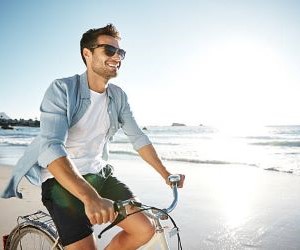Learn how to deal with punctures on long rides with prevention tips, repair techniques, and smart gear choices to keep rolling without stress.
HOW DO I AVOID OVERHEATING WHILE CYCLING IN TROPICAL CLIMATES?
Cycling in tropical climates offers stunning landscapes and year-round riding opportunities, but it also presents a serious challenge: heat stress. High humidity and relentless sun limit the body’s ability to cool itself, making overheating a real risk. Riders who don’t manage hydration, clothing, and pacing can suffer from heat exhaustion or worse. Fortunately, with the right preparation and strategies, you can thrive in hot, humid environments without sacrificing performance. This guide explains how to prevent overheating through hydration, cooling gear, pacing, and acclimatization methods tailored to tropical conditions.

Hydration and nutrition
In tropical climates, sweat rates skyrocket, and replacing lost fluids and electrolytes becomes mission-critical. Proper hydration isn’t just about drinking water—it’s about balancing electrolytes to keep muscles firing and body temperature stable.
Hydration timing
Waiting until you’re thirsty is too late. Start rides well hydrated and sip consistently every 10–15 minutes. Aim for 500–750 ml of fluid per hour, adjusting for intensity and sweat rate. Carry multiple bottles or hydration packs for longer rides where refill stops are scarce.
Drink before, during, and after rides
Use insulated bottles to keep fluids cool
Plan refill points along the route
Electrolyte replacement
Sweat contains sodium, potassium, and magnesium—all vital for muscle and nerve function. In tropical rides, plain water can dilute electrolytes and cause hyponatremia. Use sports drinks or electrolyte tablets to maintain balance, especially on rides over two hours.
Cooling through nutrition
Cold fluids, slushies, and chilled gels can help lower core temperature. Consuming smaller, frequent snacks prevents digestive strain in the heat. Favor easily digestible carbs like bananas, rice cakes, and isotonic gels to sustain energy without overwhelming the stomach.
Clothing and cooling gear
Your clothing and equipment are your first line of defense against tropical heat. Choosing the right materials and accessories can drastically reduce overheating risks while improving comfort.
Lightweight, breathable fabrics
Opt for jerseys made from moisture-wicking fabrics that promote airflow. Mesh panels and lighter colors reflect heat better than dark ones. Avoid cotton, which traps sweat and increases heat retention.
Moisture-wicking jerseys with mesh panels
Light-colored fabrics for heat reflection
UV-protective sleeves and arm coolers
Head and neck cooling
Cycling caps with sweatbands, ventilated helmets, and cooling neck gaiters enhance heat management. Some riders use cooling scarves soaked in water or ice packs placed inside helmets during rest stops for an extra cooling effect.
Specialized cooling gear
For extreme tropical rides, consider gear like ice vests used by pro teams during warm-ups. While not practical for every outing, lightweight cooling accessories such as arm sleeves or vests can help during high-heat races or training blocks.
Pacing, acclimatization, and strategy
Overheating is as much about effort and adaptation as it is about climate. By adjusting pacing, riding schedules, and gradually building heat tolerance, cyclists can thrive even in humid conditions.
Ride timing and pacing
Plan rides during cooler hours—early mornings or late evenings. On long rides, pace conservatively in the first half to avoid cumulative heat stress. Monitor heart rate or perceived exertion, as power output often drops in high heat even at the same effort level.
Avoid midday sun when possible
Start slower to adapt to rising heat
Use shaded rest stops for recovery
Acclimatization techniques
The body adapts to heat over 7–14 days of exposure. Start with shorter rides in the heat and gradually extend duration. Adaptations include increased plasma volume, improved sweat efficiency, and lower core temperature during exercise. Consistency is key—skipping several days resets adaptation.
Recognizing and managing heat stress
Know the warning signs of overheating: dizziness, chills, nausea, and sudden fatigue. At the first symptoms, slow down, find shade, and cool with cold fluids or wet clothing. Ignoring early signs risks heat exhaustion or heat stroke, which require immediate medical attention.
By combining smart hydration, breathable gear, and strategic pacing, cyclists can ride safely and strongly in tropical climates. Preparation and awareness are your best defenses against the heat, turning tropical rides into enjoyable, not punishing, experiences.
YOU MAY ALSO BE INTERESTED






